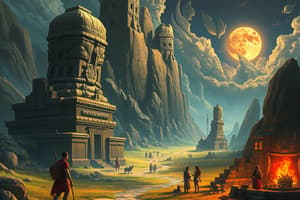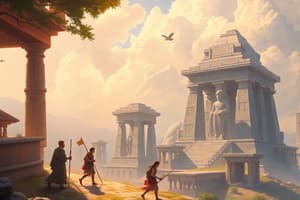Podcast
Questions and Answers
Which of the following civilizations is known for its pharaohs, pyramids, and mummification?
Which of the following civilizations is known for its pharaohs, pyramids, and mummification?
- Ancient Rome
- Ancient Egypt (correct)
- Ancient Greece
- Mesopotamia
What is the main characteristic of the Early Modern Period?
What is the main characteristic of the Early Modern Period?
- Global interconnectedness
- The development of factories and machines
- The spread of Christianity
- The rise of feudalism
- The Renaissance and Enlightenment (correct)
Which of the following is NOT a characteristic of the Middle Ages?
Which of the following is NOT a characteristic of the Middle Ages?
- The use of iron tools
- The development of gunpowder (correct)
- The dominance of the Catholic Church
- The establishment of feudalism
- The rise of trade guilds
Study Notes
Prehistory
- Refers to the period of human history before written records
- Divided into three ages:
- Stone Age: characterized by the use of stone tools, lasted from approximately 2.5 million to 10,000 BCE
- Bronze Age: marked by the use of bronze tools, lasted from approximately 3000 to 1200 BCE
- Iron Age: characterized by the use of iron tools, lasted from approximately 1200 BCE to 500 CE
Ancient Civilizations
- Mesopotamia: located in modern-day Iraq, known for the Sumerians, Babylonians, and Assyrians
- Ancient Egypt: located in northeastern Africa, known for pharaohs, pyramids, and mummification
- Ancient Greece: located in southeastern Europe, known for city-states, philosophy, and theater
- Ancient Rome: located in central Italy, known for the Roman Empire, law, and architecture
Middle Ages
- Lasted from approximately 500 to 1500 CE
- Characterized by:
- Feudalism: a social hierarchy with lords and vassals
- The Catholic Church: a dominant religious institution
- Trade and commerce: limited, with local markets and trade guilds
Early Modern Period
- Lasted from approximately 1500 to 1800 CE
- Characterized by:
- The Renaissance: a cultural and intellectual movement
- The Enlightenment: an intellectual movement emphasizing reason and individualism
- Colonialism: European exploration and settlement of the Americas and other regions
Modern Period
- Lasted from approximately 1800 to 2000 CE
- Characterized by:
- Industrialization: the development of factories and machines
- Imperialism: European colonization and domination of other regions
- World Wars: global conflicts in 1914-1918 and 1939-1945
Contemporary Period
- Refers to the period from approximately 2000 CE to the present
- Characterized by:
- Globalization: increasing interconnectedness and interdependence
- Technological advancements: rapid development of digital technologies
- Ongoing conflicts and challenges: terrorism, climate change, and social inequality
Prehistory
- Prehistory is the era before written records, providing insights into early human life and culture.
- Divided into three main ages:
- Stone Age: Utilization of stone tools, spanning approximately 2.5 million to 10,000 BCE; pivotal in early human survival and development.
- Bronze Age: Introduction of bronze tools, lasted from about 3000 to 1200 BCE; marked advancements in technology and trade.
- Iron Age: Marked by the widespread use of iron tools, occurring from around 1200 BCE to 500 CE; significant for its impact on agriculture and warfare.
Ancient Civilizations
- Mesopotamia: Situated in modern-day Iraq; birthplace of civilizations like the Sumerians, Babylonians, and Assyrians, known for innovations in writing and governance.
- Ancient Egypt: Located in northeastern Africa; famous for monumental architecture (pyramids), the role of pharaohs, and practices like mummification which reflected their beliefs in the afterlife.
- Ancient Greece: Found in southeastern Europe; renowned for the development of city-states such as Athens and Sparta, contributions to philosophy, and the birth of theater.
- Ancient Rome: Central Italy's heart, known for establishing the vast Roman Empire, pioneering law systems, and creating enduring architectural legacies such as aqueducts and coliseums.
Middle Ages
- Spanning approximately from 500 to 1500 CE, the Middle Ages saw significant societal and cultural transformations.
- Characterized by:
- Feudalism: A hierarchical system where lords provided land to vassals in exchange for military service and loyalty.
- Catholic Church: Held considerable sway over European society, influencing politics, culture, and education.
- Trade and commerce: Primarily local, limiting economic expansion, with the rise of trade guilds to regulate production and trade.
Early Modern Period
- Lasted roughly from 1500 to 1800 CE, marked by profound cultural and ideological shifts.
- Characterized by:
- The Renaissance: A revival of art and learning based on classical antiquity, influencing various disciplines and emphasizing humanism.
- The Enlightenment: An era that championed reason, science, and individual rights, laying the groundwork for modern democracy.
- Colonialism: European nations explored and established settlements in the Americas, reshaping global dynamics and economies.
Modern Period
- Encompassing 1800 to 2000 CE, this period saw radical transformations resulting from technological and geopolitical shifts.
- Characterized by:
- Industrialization: The shift from agrarian economies to industrial, marked by the rise of factories and mass production.
- Imperialism: European nations expanded their territories across Africa, Asia, and the Americas, often at the expense of local populations.
- World Wars: Major global conflicts; World War I (1914-1918) and World War II (1939-1945) redefined national boundaries and power dynamics.
Contemporary Period
- Refers to the era from around 2000 CE to the present, characterized by rapid changes and challenges.
- Characterized by:
- Globalization: Increased interconnectedness among nations through trade, communication, and culture, impacting economies and societies worldwide.
- Technological advancements: Rapid progress in digital technologies, leading to transformative changes in communication, work, and lifestyle.
- Ongoing conflicts and challenges: Issues such as terrorism, climate change, and social inequality continue to shape global politics and societies, requiring collaborative approaches.
Studying That Suits You
Use AI to generate personalized quizzes and flashcards to suit your learning preferences.
Description
Explore the early periods of human history, from the Stone Age to the Iron Age, and delve into ancient civilizations like Mesopotamia.




